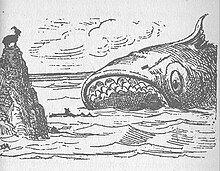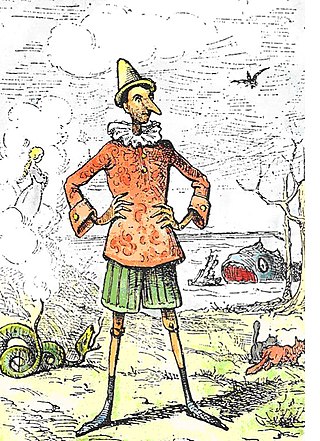
The Adventures of Pinocchio, commonly shortened to Pinocchio, is a children's fantasy novel by Italian author Carlo Collodi. It is about the mischievous adventures of an animated marionette named Pinocchio and his creator and father figure, a poor woodcarver named Geppetto.
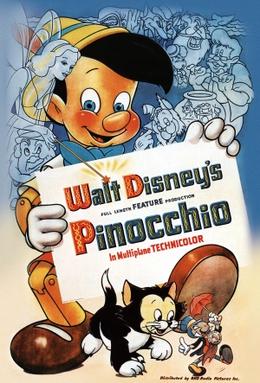
Pinocchio is a 1940 American animated musical fantasy film produced by Walt Disney Productions and released by RKO Radio Pictures. Based on Carlo Collodi's 1883 Italian children's novel The Adventures of Pinocchio, it is the studio's second animated feature film, as well as the third animated film overall produced by an American film studio, after Disney's Snow White and the Seven Dwarfs (1937) and Fleischer Studios' Gulliver's Travels (1939). With the voices of Cliff Edwards, Dickie Jones, Christian Rub, Walter Catlett, Charles Judels, Evelyn Venable, and Frankie Darro, the film follows a wooden puppet, Pinocchio, who is created by an old woodcarver, Geppetto, and brought to life by a blue fairy. Wishing to become a real boy, Pinocchio must prove himself to be "brave, truthful, and unselfish." Along his journey, Pinocchio encounters several characters representing the temptations and consequences of wrongdoing, as a cricket named Jiminy, who takes the role of Pinocchio's conscience, attempts to guide him in matters of right and wrong.

Jiminy Cricket is the Disney version of the "Talking Cricket" from Pinocchio or Mickey's Christmas Carol., a fictional character created by Italian writer Carlo Collodi for his 1883 children's book The Adventures of Pinocchio, which Walt Disney adapted into the animated film Pinocchio in 1940. Originally an unnamed, minor character in Collodi's novel who is killed by Pinocchio before returning as a ghost, he was transformed for the Disney adaptation into a comical and wisecracking partner who accompanies Pinocchio on his adventures, having been appointed by the Blue Fairy to serve as Pinocchio's official conscience. In the film, he sings "When You Wish Upon a Star", the Walt Disney Company's signature song, and "Give a Little Whistle".
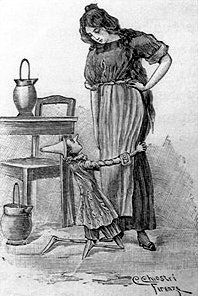
The Fairy with Turquoise Hair is a fictional character in the 1883 Italian book The Adventures of Pinocchio by Carlo Collodi, repeatedly appearing at critical moments in Pinocchio's wanderings to admonish the little wooden puppet to avoid bad or risky behavior.

Pinocchio's Daring Journey is a dark ride at Disneyland in California, Tokyo Disneyland, and Disneyland Park in Paris. Located in the Fantasyland section of each park, this ride is based on Disney's 1940 animated film version of the classic story, which was the studio's second animated feature film. The attraction tells an abbreviated version of the film, with Pinocchio escaping from Stromboli's puppet show and visiting Pleasure Island, ignoring Jiminy Cricket's advice. Monstro the whale makes an appearance, and Pinocchio is finally reunited with Geppetto and turned into a real boy.

Mangiafuoco is a fictional character who appears in Carlo Collodi's 1883 Italian book The Adventures of Pinocchio, serving as a secondary antagonist turning good.

The Coachman, also known as The Little Man (L'Omino), is a fictional character and a major antagonist from Carlo Collodi's 1883 book The Adventures of Pinocchio, in which he appears in chapters XXXI and XXXIII.
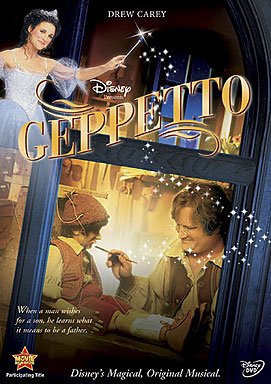
Geppetto is a 2000 made-for-television musical film based on the popular 1883 Italian children's book The Adventures of Pinocchio by Carlo Collodi starring Drew Carey and Julia Louis-Dreyfus. While not a direct adaptation of the 1940 animated film, it features a few elements such as the character of Figaro, the "I've Got No Strings" song as well as Pleasure Island. It features original songs written by Stephen Schwartz. Schwartz had developed the songs as a reunion for stars Julie Andrews and Dick Van Dyke, but Andrews was undergoing throat surgery so the idea was dropped.

The Land of Toys is a fictional location in the Italian novel The Adventures of Pinocchio (1883) that is disguised as a haven of freedom and anarchy for children, but is eventually discovered to be far more sinister.

Pinocchio is the soundtrack to the 1940 Walt Disney film of the same name, first released on February 9, 1940. The album was described as being "recorded from the original soundtrack of the Walt Disney Production Pinocchio". According to Walt Disney Records, "this is the first time the phrase 'original soundtrack' was used to refer to a commercially available movie recording."

Geppetto, also known as Mister Geppetto, is an Italian fictional character in the 1883 novel The Adventures of Pinocchio by Carlo Collodi. Geppetto is an elderly, impoverished woodcarver and the creator of Pinocchio. He wears a yellow wig resembling cornmeal mush, and consequently his neighbors call him "Polendina" to annoy him. The name Geppetto is a Tuscan diminutive of the name Giuseppe.

Pinocchio is a fictional character and the protagonist of the children's novel The Adventures of Pinocchio (1883) by Italian writer Carlo Collodi of Florence, Tuscany. Pinocchio was carved by a woodcarver named Geppetto in a Tuscan village. He is created as a wooden puppet, but he dreams of becoming a real boy. He is known for his long nose, which grows when he lies.

The Talking Cricket is a fictional character that appears in the 1883 Italian book The Adventures of Pinocchio by Carlo Collodi.
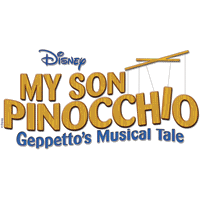
Disney's My Son Pinocchio: Geppetto's Musical Tale is a musical based on Disney's 2000 made-for-television movie Geppetto, which was in turn based on a book by David Stern, and features music and lyrics by Stephen Schwartz. As in the TV film, when Pinocchio runs away to become a star in Stromboli's puppet show, Geppetto must negotiate through a maze of adventures and comic encounters to find him.
"The Stranger" is the 20th episode of the American fairy tale/drama television series Once Upon a Time, which aired in the United States on ABC on April 29, 2012.

The Adventures of Pinocchio is a 1972 Italian five-part miniseries directed by Luigi Comencini, which originally aired weekly on Rai 1 between April 8 and May 6, 1972. Based on Carlo Collodi's 1883 novel with the same name, the miniseries received a large critical success, and had an average of twenty-one and a half million viewers during its first airing. All the episodes together make up 280 minutes of runtime.

The Devil Whale is a legendary demonic whale-like sea monster. According to myths, this whale is of enormous size and could swallow entire ships. It also resembles an island when it's sleeping, and unsuspecting sailors put ashore on its back. When the sailors start a fire, the Devil Whale awakes and attacks the ship, dragging it to the bottom of the sea. Because of this Christianity began associating the whale with the Devil. This story is found in Sinbad the Sailor.

Pinocchio is a play by Dennis Kelly, based on the classic children's story by Carlo Collodi and featuring the songs and score from the 1940 Walt Disney animated film by Leigh Harline, Ned Washington and Paul J. Smith, newly adapted by Martin Lowe.
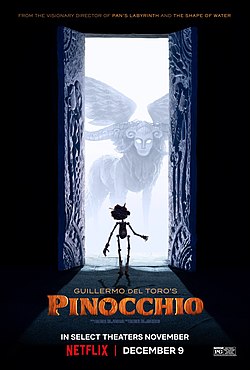
Guillermo del Toro's Pinocchio is a 2022 stop-motion animated musical dark fantasy film directed by Guillermo del Toro and Mark Gustafson, with a screenplay by del Toro and Patrick McHale. Matthew Robbins and del Toro's modified Pinocchio story, drawing from the 1883 Italian novel The Adventures of Pinocchio by Carlo Collodi, was strongly influenced by Gris Grimly's illustrations for a 2002 edition of the book. The film reimagines the adventures of Pinocchio, a wooden puppet who comes to life as the son of his carver Geppetto. Set in Fascist Italy during the interwar period, the film stars the voice of Gregory Mann as Pinocchio and David Bradley as Geppetto, alongside Ewan McGregor, Burn Gorman, Ron Perlman, John Turturro, Finn Wolfhard, Cate Blanchett, Tim Blake Nelson, Christoph Waltz, and Tilda Swinton. Pinocchio was the final film credited to Gustafson before his death in 2024.
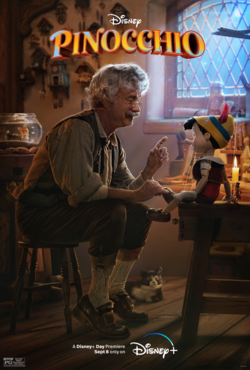
Pinocchio is a 2022 American musical fantasy film directed by Robert Zemeckis from a screenplay by Zemeckis and Chris Weitz. Produced by Walt Disney Pictures, Depth of Field and ImageMovers, this film is a live-action remake of Walt Disney's 1940 animated film Pinocchio, which is itself based on the 1883 Italian book The Adventures of Pinocchio by Carlo Collodi. It stars Tom Hanks, Cynthia Erivo, and Luke Evans with Benjamin Evan Ainsworth, Joseph Gordon-Levitt, Keegan-Michael Key, and Lorraine Bracco in voice roles. The reimagined story follows a wooden puppet named Pinocchio, who is brought to life by a blue fairy (Erivo) after being crafted by an old Italian woodcarver named Geppetto (Hanks). While the role of Pinocchio's conscience Jiminy Cricket (Gordon-Levitt) attempts to guide Pinocchio in matters of right and wrong, Pinocchio encounters a host of unsavory characters in his efforts to become a real boy.
